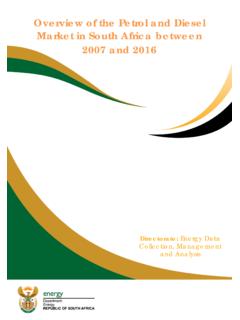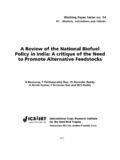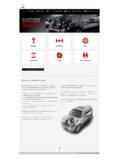Transcription of Biofuels in Asia - ACFA
1 Biofuels in Asia By Clarence Woo Executive Director 29 March 2017. ARTC 2017, Jakarta, Indonesia Who is ACFA? Working closely with fuel policymakers, regulators and stakeholders in the fuel industry, ACFA promotes and advances the use of cleaner automotive fuels based on principles of sound science, cost efficiency and sustainability of the environment. ACFA Activities Provided technical support and assistance to the Chinese stakeholders Northeast China since 2005 in upgrading its fuels from GB II to Asia currently GB VI. Promotion of clean fuels implementation has led to GCC countries to stop the Middle North use of leaded gasoline and East Africa reduce sulphur levels in the Arab region Southeast Japan's development of its Japan Biofuels program Asia 3. ACFA's Partnership with Regulators ACFA has forged close working relationships with government and policy makers in Asia and the Middle East.
2 ACFA has assisted policy makers to understand the need to have better fuel standards and the benefits of using fuel ethers to achieve their fuel policy objectives. ACFA's International Partnerships ACFA has close working relationship with many international partners. ACFA is a member of the United Nations Environment Program Partnership for Clean Fuels And Vehicles ACFA is a committee member of Clean Air Asia formed by the World Bank Agenda Biofuels quick overview Biofuels experiences in Asia Challenges face by the Asian refining sector Conclusion 6. Biofuels QUICK OVERVIEW. What are Biofuels ? Biofuels (Biodiesel, Bioethanol, Biogas ). Biofuels : fuels from a variety of sources of biomass: plant materials certain types of crops recycled or waste vegetable oils Biodiesel/bioethanol: They can replace conventional diesel / petrol entirely respectively They can be blended with diesel / petrol in different proportions: Engines generally require no modification to use 10%.
3 Ethanol blends For biodiesel, blends up to 20% are possible, but it may invalidate many manufacturers' warranties 8. Global fuel ethanol production Data Source: Renewable Fuels Association. 9. Why governments pursue Biofuels development? Data Source: Biofuels in Asia, ResearchGate, 2009. 10. Biofuels EXPERIENCES IN ASIA. Thailand The use of gasohol and biodiesel in Thailand is a result of a decree from royalty, starting when King Bhumipol sanctioning a study on converting sugar cane to alternative fuels in 1985. Thailand is first country to in Asia to introduce E20 and E85. vehicles in 2008. Target in 2036: billion litres of fuel ethanol use. Gasohol cheaper than standard gasoline due to tax incentives. Gasohol is produced domestically, primary feedstock sugarcane and cassava.
4 12. Thailand 13. Production and Market Penetration 14. Australia 6% of gasoline to be E10 mandated in New South Wales currently. 30% of gasoline to be E10 mandated in Queensland will take effect in 2017. 15. Fuel standards for ethanol The Australian Government capped the level of ethanol that can be added to petrol at 10% in July 2003. vehicle tests suggested that petrol containing ethanol blends of 20% or more could cause engine problems in some older vehicles. A requirement to label ethanol blend is required. Under the Fuel Quality for Ethanol-e85 (a fuel blend of 70 . 85% ethanol with the remainder petrol ), the fuel may only be used in cars that have been specifically built or modified to use E85. 16. Ethanol-blended fuel use in Australia 17. China Early in 2000, China implemented fuel ethanol programs, but switched course in 2010 due to increased concerns over food for fuel.
5 Move towards China V and China VI to address the serious air pollution problem in cities. China looking into second-generation biomass and biofuel production, including how to promote cellulosic and algae based Biofuels . Grain-based ethanol is banned, due to food security concerns. 2016 fuel ethanol production is forecast at billion litres, up % from 2015. 18. Subsidy cut affecting biofuel production Restrictions on grain-based ethanol and challenges in producing commercially viable cellulosic Biofuels have resulted in a policy of supporting so called Generation Biofuels , which are produced by non- grain based feedstocks such sweet sorghum and cassava. Some of these crops can be grown on marginal land and require fewer inputs, but supply is insufficient to support large- scale industrial ethanol production.
6 19. Ethanol production in China 20. India's biofuel policy National Policy on Biofuels indicative target to replace 20% of petroleum fuel consumption with Biofuels (bioethanol and biodiesel) by end of 12th Five-Year Plan (2017). 10% mandatory blending of ethanol with gasoline across all states. Partial success of implementation over the years. Contracted ethanol supply for 2016 likely to meet blending target. 21. India gasoline production and demand The projected availability of BS IV and BS V quality gasoline from domestic refineries is seen to be adequate to meet domestic demand of MMT till 2020. 22. Ethanol production and use In million litres 23. Indonesia Ethanol mandate in Indonesia since 2006, in the hope to reduce fuel imports. Biofuel program not entirely successful, due to supply constraints.
7 Limited success only seen in biodiesel program. Removal of fuel subsidies since 2015, renders ethanol fuel to be more expensive than gasoline. Closure of many ethanol production plants in Indonesia over the last few years. Only handful of stations left supplying. Indonesia moving towards Euro 4, by 2020 (or even 24. earlier). Indonesia gasoline and finished fuels forecast 25. Bioethanol mandate Given the lack of ethanol infrastructure, feedstock supply gaps, and the general focus on diesel , the GOI is unlikely to pursue ethanol blending. 26. Philippines Ethanol mandate currently is 10%, however meeting the current 10 percent ethanol blend in gasoline will not be possible due to supply shortage. Philippines rolled out Euro 4 fuel since late 2015. Philippines is a net importer for ethanol.
8 27. Production and Market Penetration 28. Vietnam Decision No. 177/2007QD-TTg by the Prime Minister dated 20 November 2007 targeted a development of Biofuels as a new and renewable energy, for use as an alternative to partially replace conventional fossil fuels, contributing to energy security and environmental protection. Government kept trying to push for the roll out of E5 &. E10, but kept postponing due to shortage of supply. Latest: E5 to be available at the petrol stations across Vietnam by January 2018. 29. Vietnam's biofuel mandate Vision to 2025: Ethanol and biodiesel output to reach million MT, satisfying some 5% of the whole country's auto fuel demand. 30. Challenges for the Vietnam's biofuel program Supply and handling infrastructure have not been fully developed.
9 For example, some gas stations are not yet equipped with E5 gasoline filling columns (as the equipment needed for these filling columns is not yet mandatory). Shutdown of many ethanol plants in Vietnam Dong Quat bio-ethanol plant, Binc Phuoc ethanol and Phu Tho ethanol - due to loss-making investments. Consumers' attitude towards E5 is negative due to: Belief that E5 is harmful for engines Inconvenience due to small number of E5 stations 31. Bioethanol production in Vietnam 32. Japan Reducing GHG and energy security are Japan's key drivers for its Biofuels campaign. Carried out extensive assessment study on the use of ethanol-blended fuel and found concerns over ethanol direct blending and increased costs to refiners. Conducted ETBE risk assessment study, and concluded that ETBE is a better choice for Japan.
10 Cost-saving Easier transition from MTBE to ETBE. Properties and benefits of ETBE similar to MTBE. ETBE can be used on a national scale vs ethanol blends only feasible locally or regionally 33. Japan's biofuel policy Basic Energy Plan states that Concerning Biofuels , which are mostly imported, Japan continues to introduce the fuels in light of international trends and technical development of the next generation of Biofuels .. 34. ETBE demand for Japan 2008 2009 2010 2011 2012 2013 2014 2015 2016 2017 2018 2019 2020 2021 2022 2023 2024 2025. 0 49 565 560 615 635 745 890 1090 1190 1415 1530 1680 1730 1770 1720 1670 1670. DK&A: Japan's ETBE demand & supply in m MT/y 35. CHALLENGES TO ASIAN REFINING. SECTOR. Challenges to the Asian refining sector Biofuel is not the only challenge the Asian refining sector faces.






